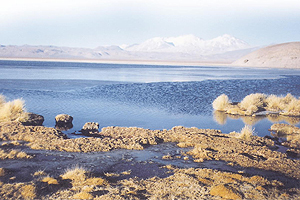The flora and fauna of this region is very similar to the Region of Antofagasta, up to the Salado Creek. Farther south, the climatic conditions change due to water flows and an increase in the rainfall.
In coastal desert sectors there are species such as Palo negro ( Helotropium stenophyllum ), Churco (Oxalis gigantean), which is a bush measuring 2 metres and a half; Coronilla de fraile (Encelia tomentosa); Cacho de Cabra (Skytanthus acutus); is a bush that grows in sandy places and which fruits have the shape of a goat horn, thus its name, and the Salitre (Frankenis chilensis).
While, the fauna inhabiting this place are mammals such as the Patagonian Fox or Andean Fox (Pseudalopex cupaeus), the Southamerican Grey Fox (Pesudalopex griseus), the Seawolf (Otaria flovesens), the Guanaco (Lama guanicoe), the Marine Otter (Lontra feline) and the Bottle Nosed Dolphin (Tursiops truncates). Among birds there are the Dominican Seagull (Larus dominicanus), the Pelican (Pelecanus thagus), the Speckled Teal ( Anas flavirostris), the The Angentine Blue Bill (Oxyura vittata), the Picui Ground-dove (Columbina picui) and the Red-Gartered Coot (Fulica armillata).
Towards the interior of the valleys, one may find reptiles like the Lagartija rayada nortina (Liolaemus alticolor) and the long-tailed snake (Philodryas chamissonis). Also, one may appreciate birds like the Piden (Pardirallus sanguinolentus landbecki) and the Chilean tinamou (Nothoprocta predicaría).
A natural phenomenon known as the desert is present here. This phenomenon doesn’t take place in the entire desert at the same time, it depends on the sprouts and location.
A few of the most representative species are the Añañuca amarilla (Rhodophiala bagnoldii), A. roja (Rhodophiala phycelloides) and A. rosada (Rhodophiala laeta), and the Huilli (Leucocoryne coquimbensis).
There are also some herbaceous plants, such as the Suspiro del campo (Nolana paradoxa atriplicifolia) and the Terciopelo (Argylia radiata).
Other species are the Pata de guanaco (Calandrinia longiscapa), the Malvilla (Cristaria aspera), the Coronilla de fraile (Globularia alypum), the Garra de leon (Leontochir ovallei), the Lirio del campo (Alstroemeria magnifica), the Oreja de zorro (Aristolochia chilensis), the Correhuela (Convolvulus chilensis), the Quisquito (Neoporteria chilensis), the Amancai (Balbisia peduncularis), the Palo negro (Heliotropium stenophyllum), the Piojillo (Malesherbia multiflora ricardi), the Algarrobilla (Balsamocarpon brevifolium), the Copiapoa (Copiapoa dealbata carrizalensis) and the Colita de oveja (Eulychia breviflora).
In the Andes mountains, we can some birds, like the Long-tailed meadowlark or Lloica (Sturnella loyca), which is recognizable for its red chest, the Chilean flamingo (Phoenicopterus chilensis), the Andean flamingo (Phoenicoparrus andinus) and the James’s flamingo (Phoenicoparrus jamesi).
Protected zones
There are three national parks in this region:
– Pan de Azucar National Park: it was created in 1985 and is found in the coastal area of the Atacama desert. It consists of 43,754 hectares, 79% of which belong to this region and the remaining 21% belongs to the region of Antofagasta.
It has a maximum altitude of 800 masl and counts with lush vegetation, especially cacti and herbaceous vegetation. Fauna is represented by a few mammals, such as the Marine otter (Lontra felina), the southern sea lion (Otaria flavescens), the otter (Lutra felina), the culpeo fox (Pseudalopex culpaeus), the south American gray fox (Pseudalopex griseus) and the Guanaco (Lama guanicoe). It is also possible to see several birds, such as the Dominican gull (Larus dominicanus), the pelican (Pelecanus thagus), the cormorant (Cormoranus guanus alcalinus), the Chilean swallow (Tachycineta meyeni) and the turkey vulture (Cathartes aura).
– Llanos de Challe National Park: it is located in the region’s coastal zone, some 40 km north of the city of Huasco. It was created in 1994 and counts with a surface of 45,708 hectares.
The park’s flora is mainly endemic and has 278 species, the most common of which are cacti, like the Copiapoa dealbata carrizalensis and the Copiapoa hyopogea.
The fauna in this place is dominated by birds, of which there are over fifty species. The most common ones are: the Andean Condor (Vultur gryphus) and the peregrine falcon (Falco peregrinus). Mammal-wise, stand outs are the Guanaco (Lama guanicoe), el south American gray fox (Pseudalopex griseus) and the Culpeo fox (Pseudalopex culpaeus). In addition, this place has an endemic amphibian, the Sapo de Atacama (Bufo Atacamensis, Atacama toad).
– Nevado Tres Cruces National Park: it takes up 59,081 hectares and is split into two sectors. The first is comprised of 80% of the park’s total surface and the Santa Rosa lagoon is found there, as well as the Maricunga saltpan and the Lumas river. The second area covers the Negro Francisco lagoon. The dryness of the air and the seasonal temperature differences are this park’s main climate characteristics. The annual average precipitation is between 100 and 120 mm.
The flora present in this place is scarce, there are only wetlands and mashes with wild grasses. However, fauna is varied, with standouts like the Andean flamingo (Phoenicoparrus andinus), the James’s flamingo (Phoenicoparrus jamesi), the Chilean flamingo (Phoenicopterus chilensis), el Patagonian crested duck (Lophonetta specularioides specularioides), the Andean goose or Piuquen (Chloephaga melanoptera), and the Tagua. One may also see large groups of guanacos and vicuñas.
Humboldt Penguin National Reserve
It is located at the border with the region of Coquimbo and is made up by three islands: Damas, Choros and Chañaral de Aceituno (this last one is the only one found in the region of Atacama). It has 859.3 hectares its main attraction are the Humboldt penguins, hence its name.
However, there are important colonies of mammals and birds, for example: south American sea lion (Otaria byronia), marine otter (Lontra felina), bottle-nosed dolphin (Tursiops truncatus), Aguilucho (Buteo polyosoma polyosoma), Pequen (Athene cunicularia cunicularia), red-legged cormorant (Phalacrocorax gaimardi), Yeco (Phalacrocorax brasilianus brasilianus), Pelican (Pelecanus thagus) and the American black vulture (Coragyps atratus).








